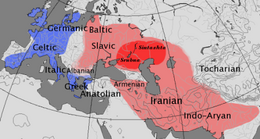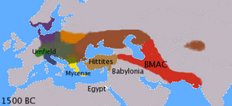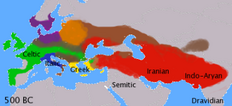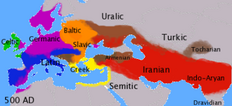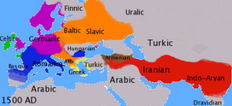Indo-European languages
| There are a lot of red links in this article! If you can, please help clean this up by fixing the links or creating the missing pages.
|
The Indo-European languages are a family of several hundred languages and dialects (443 according to the SIL estimate), including most of the major languages of Europe, as well as many in West, Central and Southern Asia. Contemporary languages in this family include Hindi, Bengali, German, English, Portuguese, Russian, Spanish (each with more than 100 million native speakers), as well as numerous smaller national or minority languages. Indo-European is the largest family of languages in the world today, with its languages spoken by approximately 3 billion native speakers; the second largest family of tongues is Sino-Tibetan. There are other, controversial supergroupings.
Contents
Descendants
Languages descended from Proto-Indo-European.
Natural languages
Category: Indo-European natlangs
Constructed languages
- Category: Indo-European conlangs
Classification
The various subgroups of the Indo-European family include (in historical order of their first attestation):
- Anatolian languages — earliest attested branch, from the 18th century BC; extinct, most notable was the language of the Hittites.
- Indo-Iranian languages, descending from a common ancestor, Proto-Indo-Iranian
- Indo-Aryan languages, including Sanskrit, attested from the 2nd millennium BC
- Iranian languages, attested from roughly 1000 BC, including Avestan, Kurdish and Persian
- Dardic languages
- Nuristani languages
- Greek language — fragmentary records in Mycenaean from the 14th century BC; Homer dates to the 8th century BC. See Proto-Greek language, History of the Greek language.
- Italic languages — including Latin and its descendants, the Romance languages, attested from the 1st millennium BC.
- Celtic languages — Gaulish inscriptions date as early as the 6th century BC; Old Irish texts from the 6th century AD, see Proto-Celtic language.
- Germanic languages (including English) — earliest testimonies in runic inscriptions from around the 2nd century, earliest coherent texts in Gothic, 4th century, see Proto-Germanic language.
- Armenian language — attested from the 5th century.
- Tocharian languages — extinct tongues of the Tocharians, extant in two dialects, attested from roughly the 6th century.
- Balto-Slavic languages, believed by many Indo-Europeanists to derive from a common proto-language later than Proto-Indo-European, while others are skeptical and think that Baltic and Slavic are no more closely related than any other two branches of Indo-European.
- Slavic languages — attested from the 9th century, earliest texts in Old Church Slavonic.
- Baltic languages — attested from the 14th century, and, for languages attested that late, they retain unusually many archaic features attributed to Proto-Indo-European.
- Albanian language — attested from the 15th century (1462); relations with Illyrian, Dacian, or Thracian proposed.
In addition to the classical ten branches listed above, there are several extinct languages, about which very little is known:
- Illyrian languages — possibly related to Messapian or Venetic; relation to Albanian also proposed.
- Venetic language — close to Italic.
- Liburnian language — apparently grouped with Venetic.
- Messapian language — not conclusively deciphered.
- Phrygian language — language of ancient Phrygia, possibly close to Greek, Thracian, or Armenian.
- Paionian language — extinct language once spoken north of Macedon.
- Thracian language — possibly close to Dacian.
- Dacian language — possibly close to Thracian and Albanian.
- Ancient Macedonian language — probably related to Greek, others propose relation to Illyrian, Thracian or Phrygian.
- Ligurian language — possibly not Indo-European; possibly close to or part of Celtic
There were no doubt other Indo-European languages which are now lost without a trace. The fragmentary Raetian language cannot be classified with any certainty.
Further subfamilies have been suggested, among them Italo-Celtic and Graeco-Aryan. Neither of these is widely accepted. Indo-Hittite refers to the hypothesis that there is a significant separation between Anatolian and all the remaining groups.
Satem and Centum languages
The Indo-European sub-branches are often classified in a Satem and a Centum group. This is based on the varying treatments of the three original velar rows. Satem languages lost the distinction between labiovelar and pure velar sounds, and at the same time assibilated the palatal velars. The centum languages, on the other hand, lost the distinction between palatal velars and pure velars. Thus, geographically, the "eastern" languages are Satem (Indo-Iranian, Balto-Slavic, but not including Tocharian and Anatolian), and the "western" languages are Centum (Germanic, Italic, Celtic). The Satem-Centum isogloss runs right between the Greek (Centum) and Armenian (Satem) languages (thought to be related by a number of scholars), with Greek exhibiting some marginal Satem features. Some scholars think that there may be some languages that classify neither as Satem nor as Centum (Anatolian, Tocharian, and possibly Albanian). It should be noted that the grouping does not imply a claim of monophyly: there never was a "proto-Centum" or a "proto-Satem", but the sound changes spread by areal contact among already distinct post-PIE languages (say, during the 3rd millennium BC).
File:IndoEuropeanTreeA.PNG Indo-European Language Tree |
Suggested superfamilies
Some linguists propose that Indo-European languages are part of a hypothetical Nostratic language superfamily, and attempt to relate Indo-European to other language families, such as South Caucasian languages, Altaic languages, Uralic languages, Dravidian languages, Afro-Asiatic languages. This theory is controversial, as is the similar Eurasiatic theory of Joseph Greenberg, and the Proto-Pontic of John Colarusso.
History
File:IE5500BP.png late Proto-Indo-European language in the Kurgan framework |
See also: Proto-Indo-European, Historical linguistics, Glottochronology.
The possibility of common origin for some of these languages was first proposed by Marcus Zuerius van Boxhorn in 1647, proposing their derivation from "Scythian". However, the suggestions of van Boxhorn did not become widely known and were not pursued. The hypothesis was again proposed by Sir William Jones, who noticed similarities between four of the oldest languages known in his time, Latin, Greek, Sanskrit, and Persian. Systematic comparison of these and other old languages conducted by Franz Bopp supported this theory, and Bopp's Comparative Grammar, appearing between 1833 and 1852 is considered the starting point of Indo-European studies as an academic discipline.
The common ancestral (reconstructed) language is called Proto-Indo-European (PIE). There is disagreement as to the original geographic location (the so-called "Urheimat" or "original homeland") from where it originated. There are two main candidates today:
- the steppes north of the Black Sea and the Caspian Sea (see Kurgan)
- Anatolia (see Colin Renfrew).
Proponents of the Kurgan hypothesis tend to date the proto-language to ca. 4000 BC, while proponents of Anatolian origin usually date it several millennia earlier, associating the spread of Indo-European languages with the Neolithic spread of farming (see Indo-Hittite).
Kurgan hypothesis
- Main article: Kurgan hypothesis
The Kurgan hypothesis was originally suggested by Marija Gimbutas in the 1950s. According to the Kurgan hypothesis, early PIE was spoken in the chalcolithic steppe cultures of the 5th millennium BC between the Black Sea and the Volga.
Currently, her theories do not hold credence with most reputable scholars. Ms. Gimbutas's so-called Kurgan peoples theory relies heavily on Kurgan burial mounds. Unfortunately, it is unproven that these so-called Kurgan peoples were ever members of the Indo-European culture-linguistic group. Precisely because known ancient Indo-European cultures, (i.e. the Indo-Aryans [people of India], the Greeks, Estruscan/Romans, and the ancient norse peoples), universally practiced cremation and not burial. This contradiction with known and recorded cultural practices of cremation amongst proven ancient, yet geographically diverse Indo-Europeans groups, casts doubt on the probability that the so-called Kurgan culture were Indo-European. With these caveats in mind, below is outlined Gimbutas' Kurgan hypothesis.
Timeline
- 4500–4000: Early PIE. Sredny Stog, Dnieper-Donets and Sarama cultures, domestication of the horse.
- 4000–3500: The Yamna culture, the prototypical kurgan builders, emerges in the steppe, and the Maykop culture in the northern Caucasus. Indo-Hittite models postulate the separation of Proto-Anatolian before this time.
- 3500–3000: Middle PIE. The Yamna culture is at its peak, representing the classical reconstructed Proto-Indo-European society, with stone idols, early two-wheeled proto-chariots, predominantly practicing animal husbandry, but also with permanent settlements and hillforts, subsisting on agriculture and fishing, along rivers. Contact of the Yamna culture with late Neolithic Europe cultures results in the "kurganized" Globular Amphora and Baden cultures. The Maykop culture shows the earliest evidence of the beginning Bronze Age, and bronze weapons and artefacts are introduced to Yamna territory. Probable early Satemization.
- 3000–2500: Late PIE. The Yamna culture extends over the entire Pontic steppe. The Corded Ware culture extends from the Rhine to the Volga, corresponding to the latest phase of Indo-European unity, the vast "kurganized" area disintegrating into various independent languages and cultures, still in loose contact enabling the spread of technology and early loans between the groups, except for the Anatolian and Tocharian branches, which are already isolated from these processes. The Centum-Satem break is probably complete, but the phonetic trends of Satemization remain active.
- 2500–2000: The breakup into the proto-languages of the attested dialects is complete. Proto-Greek is spoken in the Balkans, Proto-Indo-Iranian north of the Caspian in the Sintashta-Petrovka culture. The Bronze Age reaches Central Europe with the Beaker culture, likely composed of various Centum dialects. Proto-Balto-Slavic (or alternatively, Proto-Slavic and Proto-Baltic communities in close contact) develops in north-eastern Europe. The Tarim mummies possibly correspond to proto-Tocharians.
- 2000–1500: The chariot is invented, leading to the split and rapid spread of Iranian and Indo-Aryan from the Andronovo culture and the Bactria-Margiana Archaeological Complex over much of Central Asia, Northern India, Iran and Eastern Anatolia. Proto-Anatolian is split into Hittite and Luwian. The pre-Proto-Celtic Unetice culture has an active metal industry (Nebra skydisk).
- 1500–1000: The Nordic Bronze Age develops (pre-)Proto-Germanic, and the (pre-)Proto-Celtic Urnfield and Hallstatt cultures emerge in Central Europe, introducing the Iron Age. Proto-Italic migration into the Italian peninsula. Redaction of the Rigveda and rise of the Vedic civilization in the Punjab. Flourishing and decline of the Hittite Empire. The Mycenaean civilization gives way to the Greek Dark Ages.
- 1000 BC–500 BC: The Celtic languages spread over Central and Western Europe. Northern Europe enters the Pre-Roman Iron Age, the formative phase of Proto Germanic. Homer initiates Greek literature and early Classical Antiquity. The Vedic Civilization gives way to the Mahajanapadas. Zoroaster composes the Gathas, rise of the Achaemenid Empire, replacing the Elamites and Babylonia. The Cimmerians (Srubna culture) are replaced by Scythians in the Pontic steppe. Armenians succeed the Urartu culture. Separation of Proto-Italic into Osco-Umbrian and Latin-Faliscan, and foundation of Rome. Genesis of the Greek and Old Italic alphabets. A variety of Paleo-Balkan languages are spoken in Southern Europe. The Anatolian languages are extinct.
Competing hypotheses
Colin Renfrew in 1987 suggested that the spread of Indo-European was associated with the Neolithic revolution, spreading peacefully into Europe from Asia Minor from around 7000 BC with the advance of farming (wave of advance). Accordingly, all of Neolithic Europe would have been Indo-European speaking, and the Kurgan migrations would at best have replaced Indo-European dialects with other Indo-European dialects.
Thomas Gamkrelidze and Vyacheslav V. Ivanov in 1984 placed the Indo-European homeland on Lake Urmia. They suggested that Armenian was the language which stayed in the Indo-European cradle while other Indo-European languages left the homeland. They are also the originators of the Glottalic theory.
Some people have pointed to the Black Sea deluge theory, dating the genesis of the Sea of Azov to ca. 5600 BC, as a direct cause of the Indo-European expansion. This event occurred in still clearly Neolithic times and is rather too early to fit with Kurgan archaeology. It may still be imagined as an event in the remote past of the Sredny Stog culture, and the people living on the land now beneath the Sea of Azov as possible pre-Proto-Indo-Europeans.
Other theories exist, often with a nationalistic flavour, sometimes bordering on national mysticism, typically positing the development in situ of the proponents' respective homes. One prominent example of such are the Indian theories that derive Vedic Sanskrit from the Indus valley civilization, postulating that Vedic Sanskrit is essentially identical to Proto-Indo-European, and that all other dialects must ultimately trace back to the early Indus valley civilization of ca. 3000 BC. This theory is not widely accepted by scholars. See Indo-Aryan migration for a discussion. Another example may be the Paleolithic Continuity Theory proposed by Italian theorists that derives Indo-European from the European Paleolithic cultures.
Sound changes
- Main article: Indo-European sound laws
As the Proto-Indo-European language broke up, its sound system diverged as well, according to various sound laws in the daughter languages. Notable among these are Grimm's law in Proto-Germanic, loss of prevocalic *p- in Proto-Celtic, loss of prevocalic *s- in Proto-Greek, Brugmann's law in Proto-Indo-Iranian, as well as Satemization treated above. Grassmann's law and Bartholomae's law may or may not have been still common Indo-European.
References
- Watkins, Calvert (2000). The American Heritage Dictionary of Indo-European Roots. Houghton Mifflin. ISBN 0618082506.
- August Schleicher, A Compendium of the Comparative Grammar of the Indo-European Languages (1861/62).
- Leszek Bednarczuk (red.), Języki indoeuropejskie. PWN. Warszawa. 1986 (in Polish). .
See also
- Language family
- Proto-Indo-European language
- List of Indo-European roots
- List of Indo-European languages
- List of languages
External links
- Databases
- The Indo-European Database
- IE language family overview (SIL)
- Indo-European at the LLOW-database
- Indo-European Documentation Center at the University of Texas at Austin
- Evolution
- The Evolution of the Indo-European Languages, by Dr. C. George Boeree.
- A possible Homeland of the Indo-European Languages by Hans J. Holm
- Gray & Atkinson, article on PIE Phylogeny
- Lexicon
- Indo-European Roots, from the American Heritage Dictionary.
- Indo-European Root/lemmas (by Andi Zeneli)
| This article is one of quite a few pages about Natlangs. Indo-european natlangs:
Uralic Natlangs: Finnish * Khanty * Mansi * Mordvinic * Proto-Uralic
Isolate Natlangs: Basque * * |
